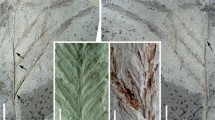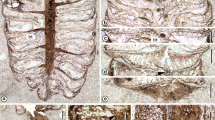Abstract
Archicupressus is a new genus of the Cupressaceae based on a permineralized conifer female cone from the Upper Cretaceous of Hokkaido. The type species,Archicupressus nihongii sp. nov., is characterized by peltate bract-scale complexes consisting of a completely fused bract and scale bearing erect seeds. Bract-scale complexes are arranged in whorls of three on the cone axis. Each complex has a bristle-like projection, the bract apex, at the top. Affinities to some genera in the Cupressaceae are discussed.
Similar content being viewed by others
References
Endlicher, S. 1847. Synopsis Coniferarum. Sheitlin and Zollikofer, Sangalli.
Florin, R. 1951. Evolution inCordaites and conifers. Acta Horti. Bergiani15: 285–388.
Hirmer, M. 1936. Die Blüten der Coniferen. I. Entwicklungsgeschichte und vergleichende Morphologie des weiblichen Blütenzapfens der Coniferen. Bibliot. Bot.114: 1–100.
Joy, K.W., A.J. Willis andW.S. Lacey. 1956. A rapid cellulose acetate peel technique in palaeobotany. Ann. Bot. N.S.20: 635–637.
LaPasha, C.A. andC.N. Miller 1981. New taxodiaceous cones from the Upper Cretaceous of New Jersey. Amer. J. Bot.68: 1374–1382.
Lemoine-Sebastian, C. 1968. La vascularisation du complexe bractée-écaille chez le Taxodiacées. Trav. Lab. Forest. Toulouse7: 1–22.
Matsumoto, T., H. Okada, H. Hirano and K. Tanabe. 1976. Mid-Cretaceous biostratigraphic succession in Hokkaido. In R.A. Reyment, ed., IGCP project Mid-Cretaceous Events. Rep. Ann. Mus. Nat. Hist. Nice33: 1–5.
Miller, C.N. 1975. Petrified cones and needle bearing twings of a new taxodiaceous conifer from the Early Cretaceous of California. Amer. J. Bot.62: 706–713.
Nishida, H. 1991. Diversity and significance of Late Cretaceous permineralized plant remains from Hokkaido, Japan. Bot. Mag. Tokyo104: 253–273.
Nishida, M., H. Nishida andT. Ohsawa. 1991. Structure and affinities of petrified plants from the Cretaceous of Northern Japan and Saghalien VI.Yezosequoia shimanukii gen. et sp. nov., a petrified taxodiaceous cone from Hokkaido. J. Jap. Bot.66: 280–291.
—,T. Ohsawa andH. Nishida. 1992. Structure and affinities of petrified plants from the Cretaceous of Northern Japan and Saghalien VIII.Parataiwania nihongii gen. et sp. nov., a taxodiaceous cone from the Upper Cretaceous of Hokkaido. J. Jap. Bot.67: 1–9.
Ohsawa, T., M. Nishida andH. Nishida. 1991a. Structure and affinities of the petrified plants from the Cretaceous of Northern Japan and Saghalien VII. Petrified Pinaceous cone from the Upper Cretaceous of Hokkaido. J. Jap. Bot66: 352–365.
—— and — 1991b. Structure and affinities of petrified plants from the Cretaceous of Northern Japan and Saghalien IX. Petrified cone ofSciadopitys from the Upper Cretaceous of Hokkaido. J. Phytogeogr. Taxon.39: 97–105.
Ohsawa, T., M. Nishida and H. Nishida. 1992. Structure and affinities of the petrified plants from the Cretaceous of Northern Japan and Saghalien X. TwoSequoia-like cones from the Upper Cretaceous of Hokkaido. J. Jap. Bot.67: in press.
Penny, J.S. 1947. Studies on the conifers of the Magothy flora. Amer. J. Bot.34: 281–296.
Pilger, R. 1926a. Taxodiaceae.In A. Engler and K. Prantl, eds. Die Naturlichen Pflanzenfamilien. 2nd edition.13: 342–360. Wilhelm Engelmann, Leipzig.
— 1926b. Cupressaceae.In A. Engler and K. Prantl, eds., Die Naturlichen Pflanzenfamilien. 2nd edition.13: 361–403. Wilhelm Engelmann, Leipzig.
Radais, M. 1894. Contribution l'étude de l'anatomie comparée du fruit des conifères. Ann. Sci. Nat. Bot. Sér. 719: 165–368.
Seward, A.C. 1919. Fossil Plants vol. 4 Cambridge Univ. Press, Cambridge.
Stopes, M.C. andK. Fujii. 1910. Studies on the structure and affinities of Cretaceous plants. Phil. Trans. Roy. Soc. London Ser. B210: 1–90.
Author information
Authors and Affiliations
Additional information
Consecutive number from the previous paper (Ohsawaet al., 1992). Supported by a Grant-in-Aid for Scientific Research from the Ministry of Education, Science and Culture of Japan to Makoto Nishida, No. 02640533.
Rights and permissions
About this article
Cite this article
Ohsawa, T., Nishida, H. & Nishida, M. Structure and affinities of the petrified plants from the cretaceous of northern Japan and Saghalien XI A cupressoid seed cone from the Upper Cretaceous of Hokkaido. Bot Mag Tokyo 105, 125–133 (1992). https://doi.org/10.1007/BF02489408
Received:
Accepted:
Issue Date:
DOI: https://doi.org/10.1007/BF02489408




